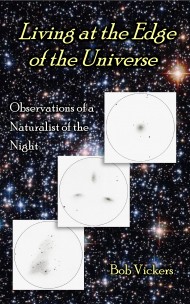Tuesday night (7 August 2012) was clear and not too hot, so I went out and did a little observing through my “new” 18” Obsession. I decided to view the targets in Sue French’s July 2012 Sky & Telescope article, By Draco’s Scaly Folds, partly because of the inclusion of the quasar Q1634+706 found in the constellation Draco. There is always something fascinating about superlatives – the biggest, the smallest, the brightest, the most distant — and this quasar is touted as one of the most distant objects visible in amateur telescopes.
So, what is a quasar? According to another S&T article by James McGaha in March 2006 “…quasars are hot accretion disks of gas spiraling toward the supermassive black hole at the core of an active galaxy nucleus.” They have an unbelievably high intrinsic brightness. According to Brian Ventrudo, Phd., on his One Minute Astronomer website, “…if this quasar was at the same distance as the Orion Nebula, [about 1344 light years] it would shine as bright as our sun!”
Most quasars are so far away that the expansion of the universe must be taken into account when determining their distance from us. Q1634+706 was much nearer to us when the light we now see left it. Its light has traveled for some 8.6 billion years to get to us but the universe has expanded since the light set out, resulting in the amazing current distance for the quasar of about 12.9 billion light years! A few years ago, I had viewed the brightest (mag 12.6) quasar known as 3C273 in the constellation Virgo at about 2 billion light years distant and I thought that was pretty incredible.
Unfortunately, viewing a quasar is not as visually spectacular as it sounds. I was a bit surprised at how easy Q1634+706 was to find and observe, but due to its great distance, it appears only as a dim “star” through my scope. At magnitude 14.4, Q1634+706 was dimly visible with direct vision but plainly visible with averted vision. This is one of those objects that causes you to pause and think about what it means for those photons to travel 8.6 billion years (more than half the currently accepted age of the universe) through intergalactic space only to end up impinging on your retina to form that tiny star-like spot.
So, the next time someone asks me, “How far can you see with that scope?” I can honestly tell them, “Pretty damn far!”



8.6 billion light years is, indeed, pretty damn far! Congrats on bagging a quasar, and an Obsession.
Thanks, Skyhiker. This quasar was not all that difficult so I am interested now in finding the most distant one I can see. The article I mentioned by James McGaha in the March 2006 S&T has a chart of possible candidates. There is another one in Draco called 1435+638 listed as R mag 15.0 and light travel time of 10.4 billion years. Yet another possiblilty is 1946+7658 R mag 15.85 and light travel time of 11.5 billion years! Kind of fun to push your limits to the edge sometimes. I’ll post my results after I get a chance to try for them.
Wow Bob! I can’t say we ever saw a quasar when we had the scope. I hope you are enjoying the scope.
David said he would like to have the brass name plate if you decide to get one made yourself.
I am definitely enjoying the scope, Ronnie, and I will be glad to send you the name plate. I will see if David Kriege can do one with all three names on it. It would be nice to have all three to show the history of the scope.
Shortly after I got my C11, I got all slack-jawed as I slowly slewed through the Virgo Cluster. Bet you can’t wait for spring to try that out.
Absolutely. I love lots of galaxy action. In fact, I’m thinking about doing the Astro League Galaxy Groups and Clusters list next. That would be really fun with this scope under some relatively dark skies at LBL.